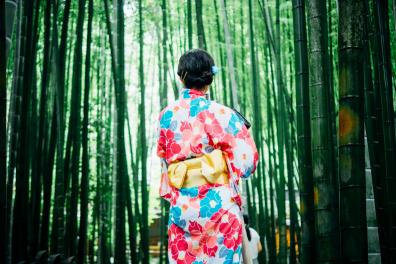Discovering the language
Japanese is the language spoken throughout the archipelago. There is of course a standard language, but also, depending on the region, dialectal variants, some of which are still very much alive. The only other language to be found is Ainu, on the island of Hokkaido, which survives among an extremely small number of speakers.
The set of sounds used by Japanese is rather restricted, and its pronunciation poses no problem for a French speaker. Its morphology is similarly undeveloped, with invariable nouns and very few verbal modifications. It is this simplicity that sometimes confuses the learner. As for its syntax, which is remarkably regular, it stands out above all for its total difference from European languages. So you have to take the plunge, forgetting your references and being open to what's new, but the journey is well worth it.
The origins and kinships of the Japanese language continue to give rise to debate, between Siberia and the Pacific, not to mention a few fanciful hypotheses. It appears, however, that the language with the closest structure is Korean. On the other hand, it's hard to imagine two languages more distinct than Chinese and Japanese.
However, it was from China that Japan borrowed its script. The immense difference in structure between the two languages, i.e. above all the existence of an abundance of Japanese grammatical tools impossible to write using Chinese characters (kanji), was to pose numerous problems. After a long period of trial and error, Japan invented its own phonetic script around the 8th-9th centuries, based on the simplification of Chinese characters: two syllabaries, hiragana and katakana (each sign corresponds to a syllable). Gradually, a hybrid system emerged, combining the use of two types of writing: Chinese ideograms and Japanese phonetic script. This is the system still in use today, whose handling is somewhat complex and demands tenacity, consistency and regularity from the learner.
In addition to writing, Chinese has provided Japan over the centuries with a mass of vocabulary, particularly abstract vocabulary and technical terms. Today, it's (American) English that's taking over, invading all domains, including the simplest objects of everyday life. There are therefore three clearly differentiated strata of vocabulary: the stratum of original Japanese, that of Sino-Japanese and that of Anglo-Japanese, to which differences in writing correspond.
Beginning to be written in the 7th century AD, the Japanese language produced great literary masterpieces in both poetry and prose from the 8th century onwards. The first literary monument, the poetic anthology of the Man.yôshû (compiled in the 8th century) contains poems produced as early as the 7th century. The beauty and refinement of some of the pieces make this poetic collection a summit rarely equaled thereafter. The French-speaking public can discover the extraordinary richness of Japanese literature throughout the centuries, and right up to the present day, thanks to the increasing number of translations on offer.
Studying Japanese at Inalco
Curriculum
The department prepares students for the Licence Langue, Littérature et Civilisation Étrangère et Régionale (LLCER), Asie et Pacifique, specializing in Japan. The Licence LLCER is a national diploma, offering a wide range of opportunities both within and outside INALCO. In terms of the number of students and teaching staff, INALCO's Japanese training program is the largest not only in France, but also in Europe. The flow of its graduates is greater than that of SOAS in London, the other major center for Japonology.
Objectives
The department's pedagogical objectives are to provide initial and continuing training in the study of the language and civilization of Japan (history, institutions, political, economic and social life, art, literature, classical and modern culture). Demanding in both written and spoken language, this course gives students not only linguistic skills, but also a rigorous and hard-working attitude.
After two years of general training, four specializations are offered to students in L3:
- History and society of contemporary Japan
- Arts and literature of Japan
- Interpreting and technical translation
- Classical Japan
Professional courses
Students can prepare the LLCER specialization in Japan in three years, but they can also enroll, at the end of their first year, in one of the following five streams:
- International Commerce stream (CI or CPEI) ;
- International Relations stream (RI) ;
- Language Didactics stream (DID or FLE) ;
- Intercultural Communication stream (CMI) ;
- Text Computing Multilingualism stream (TIM).
Mobility
The best students will have the opportunity to study in Japan: since 2013, INALCO's Japanese Studies department has been sending around 60 students on a month-long linguistic and cultural internship in Kanazawa and Tôkyô. In addition, more advanced students have the opportunity to study for a year at one of the twenty Japanese universities with which it has partnered.
